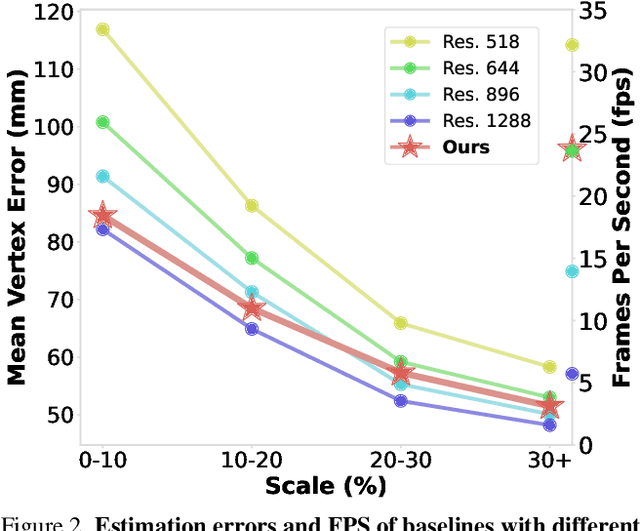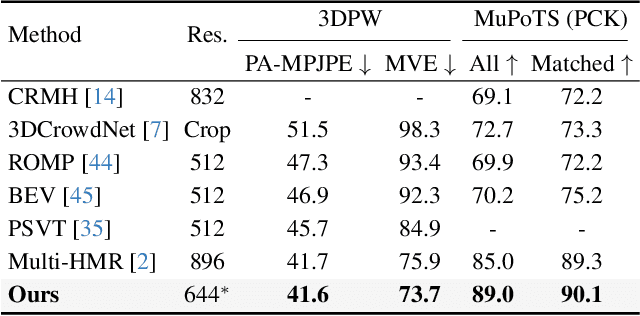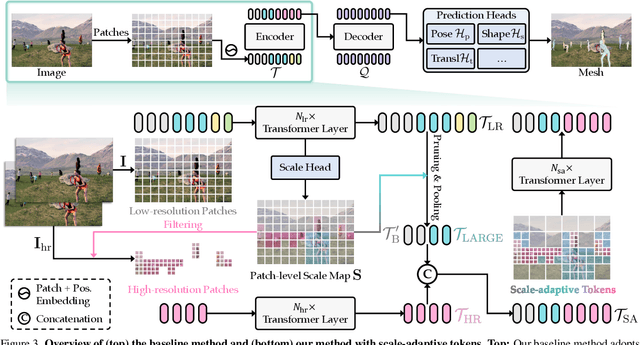Xiaoxuan Ma
RichControl: Structure- and Appearance-Rich Training-Free Spatial Control for Text-to-Image Generation
Jul 03, 2025Abstract:Text-to-image (T2I) diffusion models have shown remarkable success in generating high-quality images from text prompts. Recent efforts extend these models to incorporate conditional images (e.g., depth or pose maps) for fine-grained spatial control. Among them, feature injection methods have emerged as a training-free alternative to traditional fine-tuning approaches. However, they often suffer from structural misalignment, condition leakage, and visual artifacts, especially when the condition image diverges significantly from natural RGB distributions. By revisiting existing methods, we identify a core limitation: the synchronous injection of condition features fails to account for the trade-off between domain alignment and structural preservation during denoising. Inspired by this observation, we propose a flexible feature injection framework that decouples the injection timestep from the denoising process. At its core is a structure-rich injection module, which enables the model to better adapt to the evolving interplay between alignment and structure preservation throughout the diffusion steps, resulting in more faithful structural generation. In addition, we introduce appearance-rich prompting and a restart refinement strategy to further enhance appearance control and visual quality. Together, these designs enable training-free generation that is both structure-rich and appearance-rich. Extensive experiments show that our approach achieves state-of-the-art performance across diverse zero-shot conditioning scenarios.
Generalizable Neural Electromagnetic Inverse Scattering
Jun 26, 2025Abstract:Solving Electromagnetic Inverse Scattering Problems (EISP) is fundamental in applications such as medical imaging, where the goal is to reconstruct the relative permittivity from scattered electromagnetic field. This inverse process is inherently ill-posed and highly nonlinear, making it particularly challenging. A recent machine learning-based approach, Img-Interiors, shows promising results by leveraging continuous implicit functions. However, it requires case-specific optimization, lacks generalization to unseen data, and fails under sparse transmitter setups (e.g., with only one transmitter). To address these limitations, we revisit EISP from a physics-informed perspective, reformulating it as a two stage inverse transmission-scattering process. This formulation reveals the induced current as a generalizable intermediate representation, effectively decoupling the nonlinear scattering process from the ill-posed inverse problem. Built on this insight, we propose the first generalizable physics-driven framework for EISP, comprising a current estimator and a permittivity solver, working in an end-to-end manner. The current estimator explicitly learns the induced current as a physical bridge between the incident and scattered field, while the permittivity solver computes the relative permittivity directly from the estimated induced current. This design enables data-driven training and generalizable feed-forward prediction of relative permittivity on unseen data while maintaining strong robustness to transmitter sparsity. Extensive experiments show that our method outperforms state-of-the-art approaches in reconstruction accuracy, generalization, and robustness. This work offers a fundamentally new perspective on electromagnetic inverse scattering and represents a major step toward cost-effective practical solutions for electromagnetic imaging.
Free-form Generation Enhances Challenging Clothed Human Modeling
Nov 29, 2024



Abstract:Achieving realistic animated human avatars requires accurate modeling of pose-dependent clothing deformations. Existing learning-based methods heavily rely on the Linear Blend Skinning (LBS) of minimally-clothed human models like SMPL to model deformation. However, these methods struggle to handle loose clothing, such as long dresses, where the canonicalization process becomes ill-defined when the clothing is far from the body, leading to disjointed and fragmented results. To overcome this limitation, we propose a novel hybrid framework to model challenging clothed humans. Our core idea is to use dedicated strategies to model different regions, depending on whether they are close to or distant from the body. Specifically, we segment the human body into three categories: unclothed, deformed, and generated. We simply replicate unclothed regions that require no deformation. For deformed regions close to the body, we leverage LBS to handle the deformation. As for the generated regions, which correspond to loose clothing areas, we introduce a novel free-form, part-aware generator to model them, as they are less affected by movements. This free-form generation paradigm brings enhanced flexibility and expressiveness to our hybrid framework, enabling it to capture the intricate geometric details of challenging loose clothing, such as skirts and dresses. Experimental results on the benchmark dataset featuring loose clothing demonstrate that our method achieves state-of-the-art performance with superior visual fidelity and realism, particularly in the most challenging cases.
SAT-HMR: Real-Time Multi-Person 3D Mesh Estimation via Scale-Adaptive Tokens
Nov 29, 2024



Abstract:We propose a one-stage framework for real-time multi-person 3D human mesh estimation from a single RGB image. While current one-stage methods, which follow a DETR-style pipeline, achieve state-of-the-art (SOTA) performance with high-resolution inputs, we observe that this particularly benefits the estimation of individuals in smaller scales of the image (e.g., those far from the camera), but at the cost of significantly increased computation overhead. To address this, we introduce scale-adaptive tokens that are dynamically adjusted based on the relative scale of each individual in the image within the DETR framework. Specifically, individuals in smaller scales are processed at higher resolutions, larger ones at lower resolutions, and background regions are further distilled. These scale-adaptive tokens more efficiently encode the image features, facilitating subsequent decoding to regress the human mesh, while allowing the model to allocate computational resources more effectively and focus on more challenging cases. Experiments show that our method preserves the accuracy benefits of high-resolution processing while substantially reducing computational cost, achieving real-time inference with performance comparable to SOTA methods.
AlphaChimp: Tracking and Behavior Recognition of Chimpanzees
Oct 22, 2024



Abstract:Understanding non-human primate behavior is crucial for improving animal welfare, modeling social behavior, and gaining insights into both distinctly human and shared behaviors. Despite recent advances in computer vision, automated analysis of primate behavior remains challenging due to the complexity of their social interactions and the lack of specialized algorithms. Existing methods often struggle with the nuanced behaviors and frequent occlusions characteristic of primate social dynamics. This study aims to develop an effective method for automated detection, tracking, and recognition of chimpanzee behaviors in video footage. Here we show that our proposed method, AlphaChimp, an end-to-end approach that simultaneously detects chimpanzee positions and estimates behavior categories from videos, significantly outperforms existing methods in behavior recognition. AlphaChimp achieves approximately 10% higher tracking accuracy and a 20% improvement in behavior recognition compared to state-of-the-art methods, particularly excelling in the recognition of social behaviors. This superior performance stems from AlphaChimp's innovative architecture, which integrates temporal feature fusion with a Transformer-based self-attention mechanism, enabling more effective capture and interpretation of complex social interactions among chimpanzees. Our approach bridges the gap between computer vision and primatology, enhancing technical capabilities and deepening our understanding of primate communication and sociality. We release our code and models and hope this will facilitate future research in animal social dynamics. This work contributes to ethology, cognitive science, and artificial intelligence, offering new perspectives on social intelligence.
Scaling Up Dynamic Human-Scene Interaction Modeling
Mar 13, 2024Abstract:Confronting the challenges of data scarcity and advanced motion synthesis in human-scene interaction modeling, we introduce the TRUMANS dataset alongside a novel HSI motion synthesis method. TRUMANS stands as the most comprehensive motion-captured HSI dataset currently available, encompassing over 15 hours of human interactions across 100 indoor scenes. It intricately captures whole-body human motions and part-level object dynamics, focusing on the realism of contact. This dataset is further scaled up by transforming physical environments into exact virtual models and applying extensive augmentations to appearance and motion for both humans and objects while maintaining interaction fidelity. Utilizing TRUMANS, we devise a diffusion-based autoregressive model that efficiently generates HSI sequences of any length, taking into account both scene context and intended actions. In experiments, our approach shows remarkable zero-shot generalizability on a range of 3D scene datasets (e.g., PROX, Replica, ScanNet, ScanNet++), producing motions that closely mimic original motion-captured sequences, as confirmed by quantitative experiments and human studies.
Efficient Action Counting with Dynamic Queries
Mar 05, 2024Abstract:Temporal repetition counting aims to quantify the repeated action cycles within a video. The majority of existing methods rely on the similarity correlation matrix to characterize the repetitiveness of actions, but their scalability is hindered due to the quadratic computational complexity. In this work, we introduce a novel approach that employs an action query representation to localize repeated action cycles with linear computational complexity. Based on this representation, we further develop two key components to tackle the essential challenges of temporal repetition counting. Firstly, to facilitate open-set action counting, we propose the dynamic update scheme on action queries. Unlike static action queries, this approach dynamically embeds video features into action queries, offering a more flexible and generalizable representation. Secondly, to distinguish between actions of interest and background noise actions, we incorporate inter-query contrastive learning to regularize the video representations corresponding to different action queries. As a result, our method significantly outperforms previous works, particularly in terms of long video sequences, unseen actions, and actions at various speeds. On the challenging RepCountA benchmark, we outperform the state-of-the-art method TransRAC by 26.5% in OBO accuracy, with a 22.7% mean error decrease and 94.1% computational burden reduction. Code is available at https://github.com/lizishi/DeTRC.
Real-time Holistic Robot Pose Estimation with Unknown States
Feb 08, 2024Abstract:Estimating robot pose from RGB images is a crucial problem in computer vision and robotics. While previous methods have achieved promising performance, most of them presume full knowledge of robot internal states, e.g. ground-truth robot joint angles, which are not always available in real-world scenarios. On the other hand, existing approaches that estimate robot pose without joint state priors suffer from heavy computation burdens and thus cannot support real-time applications. This work addresses the urgent need for efficient robot pose estimation with unknown states. We propose an end-to-end pipeline for real-time, holistic robot pose estimation from a single RGB image, even in the absence of known robot states. Our method decomposes the problem into estimating camera-to-robot rotation, robot state parameters, keypoint locations, and root depth. We further design a corresponding neural network module for each task. This approach allows for learning multi-facet representations and facilitates sim-to-real transfer through self-supervised learning. Notably, our method achieves inference with a single feedforward, eliminating the need for costly test-time iterative optimization. As a result, it delivers a 12-time speed boost with state-of-the-art accuracy, enabling real-time holistic robot pose estimation for the first time. Code is available at https://oliverbansk.github.io/Holistic-Robot-Pose/.
Social Motion Prediction with Cognitive Hierarchies
Nov 08, 2023Abstract:Humans exhibit a remarkable capacity for anticipating the actions of others and planning their own actions accordingly. In this study, we strive to replicate this ability by addressing the social motion prediction problem. We introduce a new benchmark, a novel formulation, and a cognition-inspired framework. We present Wusi, a 3D multi-person motion dataset under the context of team sports, which features intense and strategic human interactions and diverse pose distributions. By reformulating the problem from a multi-agent reinforcement learning perspective, we incorporate behavioral cloning and generative adversarial imitation learning to boost learning efficiency and generalization. Furthermore, we take into account the cognitive aspects of the human social action planning process and develop a cognitive hierarchy framework to predict strategic human social interactions. We conduct comprehensive experiments to validate the effectiveness of our proposed dataset and approach. Code and data are available at https://walter0807.github.io/Social-CH/.
ChimpACT: A Longitudinal Dataset for Understanding Chimpanzee Behaviors
Oct 25, 2023Abstract:Understanding the behavior of non-human primates is crucial for improving animal welfare, modeling social behavior, and gaining insights into distinctively human and phylogenetically shared behaviors. However, the lack of datasets on non-human primate behavior hinders in-depth exploration of primate social interactions, posing challenges to research on our closest living relatives. To address these limitations, we present ChimpACT, a comprehensive dataset for quantifying the longitudinal behavior and social relations of chimpanzees within a social group. Spanning from 2015 to 2018, ChimpACT features videos of a group of over 20 chimpanzees residing at the Leipzig Zoo, Germany, with a particular focus on documenting the developmental trajectory of one young male, Azibo. ChimpACT is both comprehensive and challenging, consisting of 163 videos with a cumulative 160,500 frames, each richly annotated with detection, identification, pose estimation, and fine-grained spatiotemporal behavior labels. We benchmark representative methods of three tracks on ChimpACT: (i) tracking and identification, (ii) pose estimation, and (iii) spatiotemporal action detection of the chimpanzees. Our experiments reveal that ChimpACT offers ample opportunities for both devising new methods and adapting existing ones to solve fundamental computer vision tasks applied to chimpanzee groups, such as detection, pose estimation, and behavior analysis, ultimately deepening our comprehension of communication and sociality in non-human primates.
 Add to Chrome
Add to Chrome Add to Firefox
Add to Firefox Add to Edge
Add to Edge